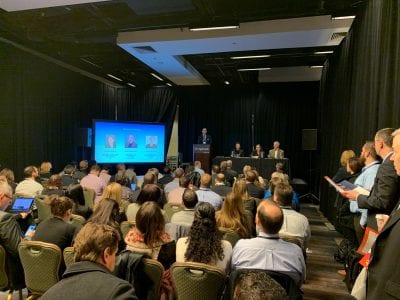As in years past, last week’s Legaltech New York conference was the right place and time to catch the pulse of an evolving industry.
Mitratech was on hand as a sponsor, an exhibitor, as a leader or participant for multiple panels, and as an interested witness to the trends on display.
To recap what those were, Steven O’Donnell, our Director of Product Marketing and Sales Enablement, and Ryan Weidman, a Senior Field Marketing Manager, provided their informed perspectives.
Steven is an 8-year Mitratech veteran and a well-recognized presence in the legal tech sector. Ryan is a newcomer to the Mitratech team, though with a longtime background in enterprise software, and brought a fresh pair of eyes to what’s underway in legal tech and legal operations.
So what stood out for them at this year’s conference?
 Legal technology is proliferating
Legal technology is proliferating
Digital transformation, both agree, is already a reality for corporate legal departments, thanks to the rapid proliferation of legal matter complexity and regulation. The success of Legaltech illustrates this; legal experts spanning a huge range of industries and functional roles attended panels, trod the long aisles of the exhibitor hall, and met with providers. Their quest? To enhance the value and effectiveness of their legal departments through tech adoption.
That’s why panels like those moderated by Steven and other Mitratech leaders, Brian McGovern and Dave Deitering, were standing-room-only as they shared the useful insights and best practices of experts who’ve already led their organizations through this transformation.
Ryan: As somebody new to the segment, I was struck by how the legal tech ecosystem is becoming more complex as legal teams look to progress. There was an impressive breadth of tech vendors in addition to consultants, system integrators and in-house counsel, with a lot more to the conference than simply general counsel, legal staff, law firms, and tech vendors.
 I come from a background in B2B enterprise software sales, where we sold in to mostly product management and operational departments. It’s been a macro trend for corporations looking to leverage third-party software solutions, so internally they can maintain best-in-class functionality and resources, while keeping their workforce focused on their core competencies.
I come from a background in B2B enterprise software sales, where we sold in to mostly product management and operational departments. It’s been a macro trend for corporations looking to leverage third-party software solutions, so internally they can maintain best-in-class functionality and resources, while keeping their workforce focused on their core competencies.
Steven: As in-house Legal Operations and law firm operations expand, the sheer number of technologies being offered is growing. This was evidenced to me by the sheer number of vendors at the conference who were involved in e-Discovery, time tracking, compliance, legal spend management, analytics, as well as the alternative service providers.
The conference can be quite overwhelming to someone new to Legal Ops who’s been charged with planning and building their legal ecosystems, and who wants to partner with proven vendors and solutions.
 There’s a trend toward data management
There’s a trend toward data management
Steven: Data is proliferating at an incredible rate, and Legal is trying to find the right ways to take advantage of it. Just because the data is there does not make it meaningful, so how does Legal Ops create dashboards, use benchmarking, or leverage AI to create useful analytics and insights?
In my session, for instance, we introduced the Data Reporting Maturity Model, which shows how a legal team can grow from a “table stakes” level where there are pretty few dimensions to its KPIs and limits to the UX it’s using, up to the “innovative” level where they can use leading-edge interactive dashboards, real-time data, and automated alerts.
Ryan: I relate this back to another trend, the Internet of Things; we’re surrounded by so many new tools, and we’re digitizing workflows, and letting technology do more and more of the everyday gruntwork for us through connectivity. With so much of a company’s legal work moving to the cloud and the digital ecosystem, it opens up new worlds of challenges – in data privacy and regulatory challenges – and also some huge opportunities.
Legal departments will be able to access unfathomable amounts of data that, if they’re organized and analyzed effectively, can produce really rich insights, and those can lead to better business decision-making.
 Data privacy is creating new challenges
Data privacy is creating new challenges
Steven: In-house legal teams want to protect their companies from risk in what may soon become a fragmented landscape of data privacy laws and regulations. I’m positive that’s why we saw a surprising amount of buzz around the work we’ve been doing with KP Labs, which drove a lot of conversations and demos at our booth, where more than a few attendees walked in asking about our co-promotion with KPL around consumer data privacy request portals.
It’s not that we were the only ones on the floor offering solutions in that vein; there are providers on the GRC side who are also trying to meet a really sudden and prominent need in the marketplace.
 Diversity is front-and-center
Diversity is front-and-center
Steven: One clue? The fact that the keynote address on the first day of Legatech touched on this topic. The legal industry as a whole has diversity challenges, and forward-thinking companies are reviewing diversity in their corporate legal departments, law firms, and vendors, and even suppliers other departments might contract with.
 Legal tech benefits companies of all sizes
Legal tech benefits companies of all sizes
Ryan: You don’t have to have an in-house team of 50 or more to benefit from legal ops and legal tech. Technologies are scaling to meet legal operations professionals “where they are” when it comes to their size and needs; workflow automation for legal services is just one example.
Once upon a time, legal departments thought they had to level up to a certain size to be able to adopt dedicated software, and that’s very similar to how it used to be in other categories. But just like in those segments, providers have to evolve what they provide so the solutions are more scalable and customizable, and the reality becomes that even small legal teams are starting to realize the benefits.
 A desire for common standards in legal use case sharing
A desire for common standards in legal use case sharing
Steven: I think there’s a lot of enthusiasm around the idea of sharing legal tech use cases among the community, we’ve certainly see that with our own Co-Innovation Center. Sharing and understanding the use cases of their peers is why Legal Ops professionals attend Legaltech, or CLOC, ACC, or other conferences.
This year, I encountered a lot of desire among the ones I met at Legaltech for there to be common standards applied for the most common use cases. That’s not to say everyone uses the exact same process, but it’s more that everyone wants to be able to use the same starting point as they begin to develop a process of their own. Going in, everyone can have the same expectation of what the core attributes will be of a use case for “matter management” or “consumer data privacy requests.”
Ryan: It’s a matter of everyone speaking the same language, using the same lexicon, and applying common parameters, and that’s something that develops along the way in most evolving technology sectors.
 Outside counsel specialization and ALSPs are driving changes
Outside counsel specialization and ALSPs are driving changes
Steven: More law firms are moving toward specialization in what services they provide, and in-house departments are increasingly awarding work on the basis of analytics about what tasks a firm does best. Combined with the rise of Alternative Legal Service Providers, there’s more opportunity for Legal Ops to bring certain types of work in house, and outsource other types. This also reduces the number of firms they do business with.
This was discussed in Dave Deitering’s panel; getting the mix of inside counsel and outsourced work optimized can involve managing big changes, but the upside is that it creates opportunities to make processes more efficient and reduce costs pretty significantly. Based on what I saw, and what we heard from nearly everyone, this will just become more and more prevalent as Legal Ops becomes more familiar with technologies that can help them in reaching the right balance.
 More media coverage is a sign of change
More media coverage is a sign of change
 Steven: Legaltech media coverage increased this year…a great deal, I would have to say. There were a lot of reporters, content creators, and industry analysts attending the conference. There were the usual industry media outlets on hand, as you’d expect, but CNBC showed up, too, and did an interview with Mike Williams. When an event like this starts to get traction with bigger channels, that’s a sign they’ve begun to take notice of something profound that’s happening.
Steven: Legaltech media coverage increased this year…a great deal, I would have to say. There were a lot of reporters, content creators, and industry analysts attending the conference. There were the usual industry media outlets on hand, as you’d expect, but CNBC showed up, too, and did an interview with Mike Williams. When an event like this starts to get traction with bigger channels, that’s a sign they’ve begun to take notice of something profound that’s happening.
Ryan: There’s a quote, “nothing could be older than the daily news.” By the time the general media tells you a trend or a change is happening, that pretty much means it’s already in fourth or fifth gear. That’s the sense I got from the conference, that we’re really speeding toward some amazing and very broad changes in the next few years.



